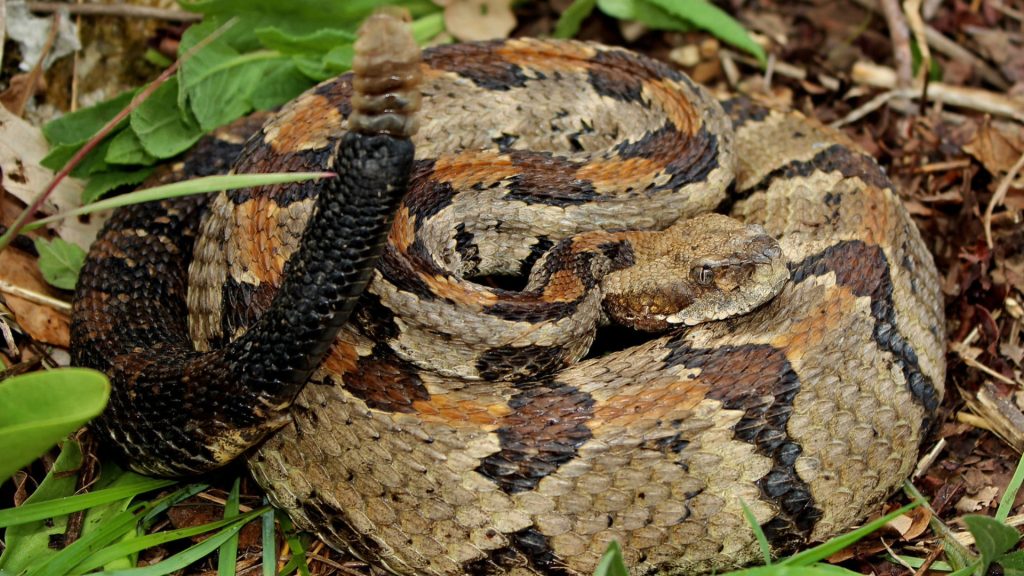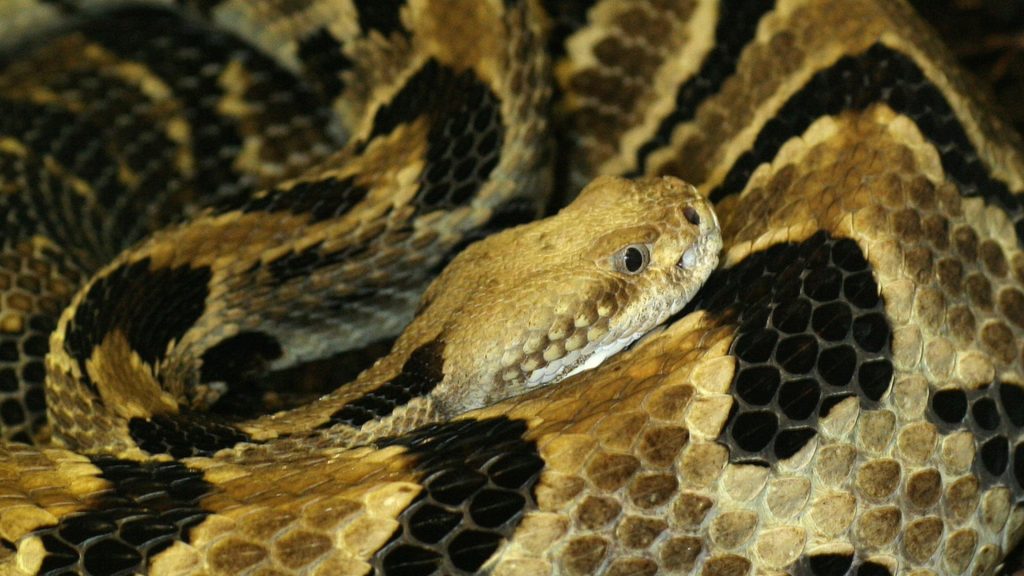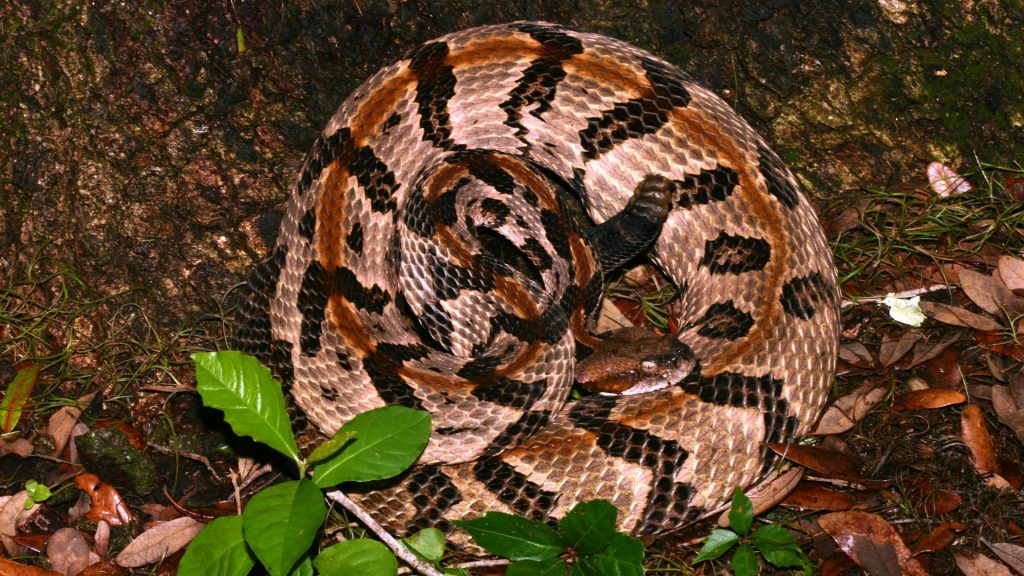At over 74 inches long and weighing in at a hefty 28 pounds, the timber rattlesnake captured in New Jersey’s Pine Barrens 1939 set records as the largest ever recorded. To put its size into perspective, this behemoth stretched over six feet from head to tail, dwarfing even healthy adult males that typically reach just three to four-and-a-half feet.
Its massive length and weight reflected the apex of gigantism for a species infamous as the most dangerous venomous serpent in the northeastern United States. Yet despite its fearsome reputation, public encounters with these shy creatures remain extraordinarily rare.
Introduction to the Timber Rattlesnake: A Formidable Predator
Timber rattlesnakes, also known as canebrakes or black rattlesnakes, are formidable predators that strike awe and fear in those who encounter them in the forests of the eastern United States they inhabit.

Their potent venom and large size, with some giants reaching over 6 feet long, make them a danger to humans if provoked. However, while timber rattlesnake bites can be lethal if untreated, these snakes tend to be reclusive and avoid contact with people when possible.
How To Identify This Viper
These pit vipers are easily identified by their namesake rattle on the end of their tails and their unique color patterns of black, brown, gray, and yellowish scales.

Timber rattlers often use a “sit-and-wait” hunting strategy, remaining camouflaged and motionless until prey comes within striking distance. They primarily feed on small mammals like squirrels, chipmunks, and rabbits.
Good For the Ecological System, But Lethal
While timber rattlesnakes play an important ecological role and their bites are quite rare, proper caution should still be exercised if one is encountered. Their hemotoxic venom can rapidly lead to severe swelling, tissue damage, and other medical complications if left untreated.

However, if given a wide berth and not threatened, these snakes will likely slip away to continue their mysterious existence deep in the deciduous forests of America.
The Record-Breaking Giant: Over 6 Feet of Rattling Terror
The largest timber rattlesnake ever documented stretched an astounding 6.2 feet long, cementing its status as a giant among deadly serpents.

This astonishing length far exceeds most timber rattlers’ typical 3 to 5 feet range. Weighing likely over 10 pounds, this behemoth displays the tremendous size these vipers can attain.
Spotted in The Lone Star State
Reports indicate the mammoth rattler was spotted crossing a road in Texas’ logging country in the 1990s. Witnesses gauged its length spanned over two lanes, suggesting dimensions over 9 feet.

While exact metrics prove difficult to verify decades later, experts agree this sighting showcases the upper limits of timber rattlesnake sizes.
Optimal Conditions to Thrive
These exceptional giants reveal that timber rattlers can achieve remarkable growth under optimal conditions. Abundant prey, ideal habitat, and genetics may all play roles in the emergence of such outliers. And longevity contributes too – timber rattlers may survive over 30 years in captivity.

For comparison, the average mature timber rattlesnake measures 2.5 to 5 feet long and weighs 1.1 to 3.3 pounds. Even compared to others in its species, this lumbering leviathan truly earns the title of giant. Its exceptional size likely afforded advantages in hunting large prey and gave pause to would-be predators.
Key Identifying Traits: Patterns, Scales and Deadly Venom
Timber rattlesnakes are large, venomous pit vipers throughout the eastern United States. They have a reputation as one of the most dangerous snakes in North America due to their size and highly potent venom. Timber rattlers possess several key traits that allow for identification, including:

Coloration and Patterns: Timber rattlesnakes showcase a combination of dark chevrons, blotches, stripes, and bands over gray, brown, yellow, or black base scales. The tail features dark bands as it nears the signature rattle. The head exhibits shades of brown, gray, or yellow with distinctive dark lines from the eyes to the jaws.
Habitat Forests and Fallen Logs
Timber rattlesnakes thrive in deciduous forests and woodlands in the eastern United States, favoring steep, rugged terrain areas. The heavy tree cover provides shade and shelter, while the slopes allow efficient basking and hibernation.

Within these wooded habitats, pregnant females seek out open rocky outcroppings which offer higher temperatures to incubate the development of young. Males and non-gravid females tend to remain in dense forests.
Hunting Small Mammals
All timber rattlers are adept hunters, using fallen logs and branches as perches for ambush attacks. Their prey consists primarily of small mammals like squirrels, chipmunks, mice, and rabbits. They will also consume smaller reptiles and amphibians. Their lightning-quick strike allows them to seize unsuspecting prey with extreme precision.

Their venom’s potency and ability to blend into the dappled forest floor make timber rattlers formidable predators. However, they are shy and defensive, typically avoiding contact with humans. When threatened, they usually remain motionless or retreat to safety. Bites occur infrequently and are rarely fatal with proper medical treatment.
Conservation Efforts for the Mysterious Timber Rattler
Timber rattlesnakes inhabit deciduous forests across the eastern United States, with a particular affinity for remote, mountainous terrain. As human development encroaches upon their habitat, conservation efforts seek to protect the remaining populations of these misunderstood pit vipers.

To aid conservation, states have enacted timber rattlesnake protections, including: Legal safeguards – Harvesting or killing timber rattlers carries penalties in multiple states. For example, New York bans collection and sets fines up to $250. Monitoring programs – Radio telemetry and mark-recapture studies track timber rattler movements, habitat usage, and survival rates. These data inform protective policies. As scientists uncover more about the life history of timber rattlesnakes, conservationists gain valuable insights into preserving these mysterious creatures. Continued efforts to reduce human pressures and maintain habitat connectivity promise a more secure future for these forest-dwelling pit vipers.





GIPHY App Key not set. Please check settings